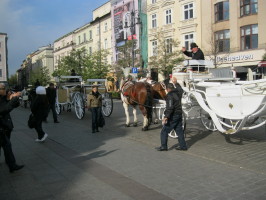During the late Middle Ages, the Cracow Market Square, being the cent re of Jagiellonian state, was a place teeming with life and clamouring with many languages. Its economic preeminence was built on long-distance trade. Cracow prospered by dint of being located at the junction of important north-south and east-west trade routes. The city expanded as a result of being right where Europe’s two great economic and commercial zones. The Hanseatic League and the Central European Mining Region came into contact. Cracow was granted many economic privileges and did not shy away from exploiting its position as a major trade centre.
re of Jagiellonian state, was a place teeming with life and clamouring with many languages. Its economic preeminence was built on long-distance trade. Cracow prospered by dint of being located at the junction of important north-south and east-west trade routes. The city expanded as a result of being right where Europe’s two great economic and commercial zones. The Hanseatic League and the Central European Mining Region came into contact. Cracow was granted many economic privileges and did not shy away from exploiting its position as a major trade centre.
 The beginnings of Cracow, one of the most admired cities in Europe, are lost in the mists of time. The imposing architecture preserved on Wawel Hill bears testimony to the splendour of the realm of the Piasts and Jagiellonians. The main Market Square has been the heart of the city since mid 13th century. It was set up following the incorporation of Cracow under magdeburg law in 1257 and imediately became the most important public area of the city and remains so to this days.
The beginnings of Cracow, one of the most admired cities in Europe, are lost in the mists of time. The imposing architecture preserved on Wawel Hill bears testimony to the splendour of the realm of the Piasts and Jagiellonians. The main Market Square has been the heart of the city since mid 13th century. It was set up following the incorporation of Cracow under magdeburg law in 1257 and imediately became the most important public area of the city and remains so to this days.
Going beneath the cobblestone surface of the Market Square you can see the exhibition. It is like traveling back in time. It takes five meters to tell the history of the Market Square. What I was able to see here is a result of archeological research that began in the summer 2005. The level of the ground has been steadily raised since then as a result of human activity. This process, barely perceptible at first, sped up dramatically during 14th century due to a new method of ceaning city streets and squares that was adopted through Europe. Once the refuse was piled up, it was covered with sand instead of being carted away. The burghers of Cracow then hit upon a more effective way to tidy up their city-what had once been  ground foors of tenements became cellars. These layers have preser ved thousands of items that were either lost or left behind back then. These accumulated layers are used as archeological evidence-the mute witnesses of history.
ground foors of tenements became cellars. These layers have preser ved thousands of items that were either lost or left behind back then. These accumulated layers are used as archeological evidence-the mute witnesses of history.
The trip to the cellars of market square was particullary interesting. It is always better to hire a guide. I was accompanied by a god one with whom I saw: long distance trade routes, key export goods of Cracow, medieval cobblestone in the Cloth Hall Concourse and Cross, 14th century’s cobblestone, reconstructiong of 12th workshops and a medieval merchant’s stall, relicts of a burnt-down settlement, 11th cementary, 13th Bolesław stalls, Big Scales, model of the city in 15th, and much more.
The Cracow Cloth Hall, 15th century
The first cloth chamber, a row of wooden compartments where the Cloth Hall now stands, was founded by Prince Boleslaw V the Chaste sometime after 1257. Thirty six brick chambers were erected in the mid-14th century. These were arranged in two rows along an internal street intersected by a cross-street.
 The end chambers of the west row had two cloth-cutting rooms. The building was extended at the end of the 14th century to create an imposing editice and to replace the internal street with a high hall. This was probably when the basement underneath the chambers was built. The Cloth Hall was rebuilt in the Renaissance style after a fire in 1555 and a ceiling was added halfway up the hall to create more floor space. A thorough renovation, followed by an extension to the building, was carried out in 1875-1879, by Tomasz Pryliński introduced new elements to give the Cloth Hall the apperance it has today.
The end chambers of the west row had two cloth-cutting rooms. The building was extended at the end of the 14th century to create an imposing editice and to replace the internal street with a high hall. This was probably when the basement underneath the chambers was built. The Cloth Hall was rebuilt in the Renaissance style after a fire in 1555 and a ceiling was added halfway up the hall to create more floor space. A thorough renovation, followed by an extension to the building, was carried out in 1875-1879, by Tomasz Pryliński introduced new elements to give the Cloth Hall the apperance it has today.







